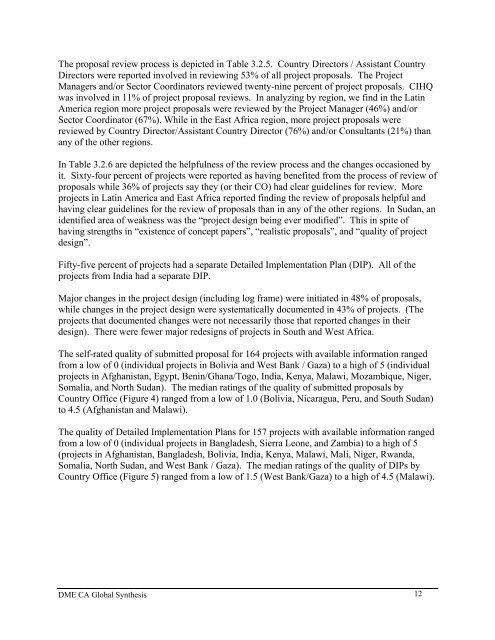Design, Monitoring, and Evaluation – Capacity Assessment
Design, Monitoring, and Evaluation – Capacity Assessment
Design, Monitoring, and Evaluation – Capacity Assessment
You also want an ePaper? Increase the reach of your titles
YUMPU automatically turns print PDFs into web optimized ePapers that Google loves.
The proposal review process is depicted in Table 3.2.5. Country Directors / Assistant Country<br />
Directors were reported involved in reviewing 53% of all project proposals. The Project<br />
Managers <strong>and</strong>/or Sector Coordinators reviewed twenty-nine percent of project proposals. CIHQ<br />
was involved in 11% of project proposal reviews. In analyzing by region, we find in the Latin<br />
America region more project proposals were reviewed by the Project Manager (46%) <strong>and</strong>/or<br />
Sector Coordinator (67%). While in the East Africa region, more project proposals were<br />
reviewed by Country Director/Assistant Country Director (76%) <strong>and</strong>/or Consultants (21%) than<br />
any of the other regions.<br />
In Table 3.2.6 are depicted the helpfulness of the review process <strong>and</strong> the changes occasioned by<br />
it. Sixty-four percent of projects were reported as having benefited from the process of review of<br />
proposals while 36% of projects say they (or their CO) had clear guidelines for review. More<br />
projects in Latin America <strong>and</strong> East Africa reported finding the review of proposals helpful <strong>and</strong><br />
having clear guidelines for the review of proposals than in any of the other regions. In Sudan, an<br />
identified area of weakness was the “project design being ever modified”. This in spite of<br />
having strengths in “existence of concept papers”, “realistic proposals”, <strong>and</strong> “quality of project<br />
design”.<br />
Fifty-five percent of projects had a separate Detailed Implementation Plan (DIP). All of the<br />
projects from India had a separate DIP.<br />
Major changes in the project design (including log frame) were initiated in 48% of proposals,<br />
while changes in the project design were systematically documented in 43% of projects. (The<br />
projects that documented changes were not necessarily those that reported changes in their<br />
design). There were fewer major redesigns of projects in South <strong>and</strong> West Africa.<br />
The self-rated quality of submitted proposal for 164 projects with available information ranged<br />
from a low of 0 (individual projects in Bolivia <strong>and</strong> West Bank / Gaza) to a high of 5 (individual<br />
projects in Afghanistan, Egypt, Benin/Ghana/Togo, India, Kenya, Malawi, Mozambique, Niger,<br />
Somalia, <strong>and</strong> North Sudan). The median ratings of the quality of submitted proposals by<br />
Country Office (Figure 4) ranged from a low of 1.0 (Bolivia, Nicaragua, Peru, <strong>and</strong> South Sudan)<br />
to 4.5 (Afghanistan <strong>and</strong> Malawi).<br />
The quality of Detailed Implementation Plans for 157 projects with available information ranged<br />
from a low of 0 (individual projects in Bangladesh, Sierra Leone, <strong>and</strong> Zambia) to a high of 5<br />
(projects in Afghanistan, Bangladesh, Bolivia, India, Kenya, Malawi, Mali, Niger, Rw<strong>and</strong>a,<br />
Somalia, North Sudan, <strong>and</strong> West Bank / Gaza). The median ratings of the quality of DIPs by<br />
Country Office (Figure 5) ranged from a low of 1.5 (West Bank/Gaza) to a high of 4.5 (Malawi).<br />
DME CA Global Synthesis 12
















![CynefinFramework final [Read-Only]](https://img.yumpu.com/19017304/1/190x135/cynefinframework-final-read-only.jpg?quality=85)